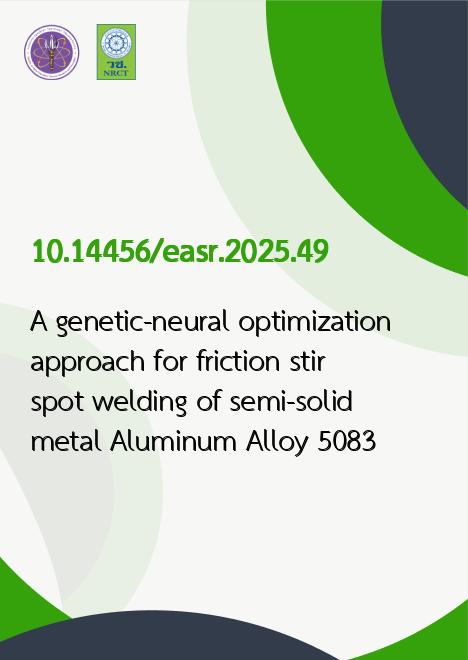
|
A genetic-neural optimization approach for friction stir spot welding of semi-solid metal Aluminum Alloy 5083 |
|---|---|
| รหัสดีโอไอ | |
| Creator | Yodprem Pookamnerd |
| Title | A genetic-neural optimization approach for friction stir spot welding of semi-solid metal Aluminum Alloy 5083 |
| Contributor | Konkrai Nakowong, Duenrung Suwannasopa, Apisit Kaewchalun, Jiraporn Lamwong |
| Publisher | Faculty of Engineering, Khon Kaen University |
| Publication Year | 2568 |
| Journal Title | Engineering and Applied Science Research |
| Journal Vol. | 52 |
| Journal No. | 5 |
| Page no. | 541-550 |
| Keyword | Friction Stir Spot Welding, Aluminum Alloy 5083, Artificial Neural Network, Genetic Algorithm, Optimization |
| URL Website | https://ph01.tci-thaijo.org/index.php/easr/index |
| Website title | Engineering and Applied Science Research |
| ISSN | 2539-6161 |
| Abstract | Friction Stir Spot Welding (FSSW) of Semi-Solid Metal (SSM) Aluminum Alloy 5083 poses challenges due to nonlinear interactions between process parameters and mechanical properties. Traditional optimization methods, such as Response Surface Methodology (RSM), provide statistical modeling but often fail to capture these complexities accurately. This study integrates Artificial Neural Networks (ANNs) with Genetic Algorithms (GAs) and Response Surface Methodology (RSM) to develop a hybrid optimization framework for FSSW parameter selection, aiming to enhance weld strength and hardness while minimizing the number of experimental trials. The ANN model, trained using a feed-forward backpropagation algorithm with the Levenberg-Marquardt learning rule, predicts tensile shear strength and weld hardness based on key parameters: rotational speed, travel speed, and dwell time. GA optimizes these parameters through an evolutionary search, while RSM validates the results and assesses parameter interactions. The optimized parameters 2143.93 RPM, 14.33 mm/min, and 6.58 s yield a shear strength of 5999.99 N. ANN exhibited lower mean absolute error (MAE) and root mean squared error (RMSE) than RSM, confirming superior predictive capability. However, RSM provided statistical validation, ensuring robust insights. The findings highlight the effectiveness of AI-driven optimization in welding applications, reducing experimental trials while ensuring optimal mechanical performance. Future research should explore the integration of deep learning and real-time sensor feedback for further enhancement. |